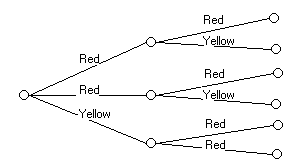A tree diagram is a good aid for understanding counting problems and probability problems. A tree diagram is worked through in steps, one step after another. With every step you have to make a choice between the possibilities, which are represented by the branches.
There are different kinds of tree diagrams: Free or irregular trees and regular trees.
In free trees a step can hold while other steps will go on. Also the number of branches can be completely different. An example of such a tree is shown here.

There are two types of regular trees
Tree diagrams having the same amount of possibilities at each step and tree diagrams losing one branch at every step. These tree diagrams can be regarded as a graph of balls you draw form an urn. The two ways of drawing are drawing with replacement and drawing without replacement.
The result of Drawing with replacement is a tree with the same amount of branches every step. An example is shown below.
There is a separate section for this kind of tree: Regular Trees

The result of Drawing without replacement is a tree loosing a branch at every step.
An example is shown below.
There is a separate section for this kind of trees: Urn
